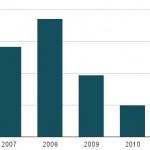Why Urban Renewal Faces Resistance In Idaho

Molly Messick / StateImpact Idaho
Melinda Anderson shows off what will be a new downtown headquarters for dairy manufacturer Glanbia. It's a project aided by Twin Falls' urban renewal agency.
Urban renewal districts allow communities to leverage property tax dollars to support local economic development. There are more than 60 of them in Idaho. But this legislative session has brought fresh signs that, in some corners, urban renewal isn’t exactly popular – even as it supports the state’s most touted new company.
Melinda Anderson has worked in economic development for twenty years, focusing on small communities.That brought her to Twin Falls, and gave her the chance to work on the biggest economic development deal she’s ever been a part of.
Last week, she took me for a drive. “You see those tall silos and that tall building?” she exclaimed as we approached the plant. “That’s Chobani! Just from a physical standpoint, it’s just massive!”
We got out of the car to look at the oblong white building that’s a new feature of Twin Falls’ north side. Clearly, Anderson is excited. You’d be hard-pressed to find a local or state official who’s not. The Greek yogurt plant employs hundreds of workers. It buys milk from local dairies. Anderson says it’s a testament to the importance of urban renewal.
“It was able to pay for all of the new infrastructure, mostly water and wastewater improvements, that needed to be made,” Anderson explained. “So that’s the big role that urban renewal played in this process.”
Basically, the urban renewal process generated $30 million dollars. That’s two thirds of the total incentives – federal, state and local – that helped convince Chobani to choose Twin Falls, Idaho. Without that money, Anderson says, this behemoth yogurt plant wouldn’t be where it is.
“They would have absolutely gone someplace else,” she says. “We would not have that investment here in Twin Falls.”
How does urban renewal funding work? Say a city council wants to achieve something, like job growth, or downtown revitalization. It forms an urban renewal agency. With the city council’s approval, that agency has the authority to draw a line around a section of the city to create an urban renewal district. For the next 20 years, any taxes on increased property value in that district can go to the urban renewal agency. In Twin Falls, the agency leveraged those future tax dollars to secure a bond. And that’s how they made infrastructure improvements Chobani needed.
It’s a process that draws pithy criticism from Randal O’Toole, a senior fellow with the libertarian Cato Institute. “It’s portrayed as free money,” he says. “Nobody loses, everybody gains. And it’s not true!”
O’Toole points to the example of California, which did away with urban renewal districts in 2011. He alleges that urban renewal agencies siphon off tax dollars that would otherwise go to schools and other local services. He says communities are offering up precious local dollars unnecessarily.
“If cities weren’t engaging in this kind of bribery to get corporations to move to their cities, where would the plant have located?” he asks. “It probably would have located exactly where it did anyway.”
O’Toole authored an Idaho Freedom Foundation report that calls for getting rid of urban renewal agencies in the state. Last year, a legislative committee printed a bill to do just that. This session has seen more signs of opposition. A draft personal property tax bill singled out urban renewal districts by giving them no replacement funding.
Boise attorney Ryan Armbruster says that would be a mistake. “The ability to implement tax increment financing is the only local economic development tool that’s available,” he explains.
Armbruster works with urban renewal agencies. He says urban renewal funds are key because they give communities a way to improve downtown infrastructure, or meet the needs of a particular business, like Chobani. But he acknowledges the resistance the agencies face.
“I think the pushback at some levels has centered on the fact that these folks are not elected by the public,” he says. “Does that create an issue? Are there monies being spent that shouldn’t be spent? I think that’s, you know, a fairly philosophical question to ask.”
It’s a philosophical question because it gets back to something the Cato Institute’s Randal O’Toole said — that if no communities offered urban renewal funds, companies would be left to choose the locations that serve them best. Future tax dollars wouldn’t be sacrificed in the name of economic development.
Susie Davidson of the Idaho Department of Commerce says that’s a fine idea, in theory.
“Theoretically, it would be great if everyone said, ‘Okay, starting tomorrow no one would offer incentives.’ But who would be the first to do that?” she asks.
Davidson is the department’s business attraction manager. Like it or not, she says, economic development is competitive. The fact is that businesses – she calls them customers – have the upper hand.
“The customer has all the cards,” she says. “They know what their cost structure is and what they need to do to be profitable and to decide to establish a site. Then we have the opportunity to play the cards that we have.”
It’s not ideal. But not participating in that system could have costs, too. Costs like that gleaming new yogurt plant on the outskirts of Twin Falls.

